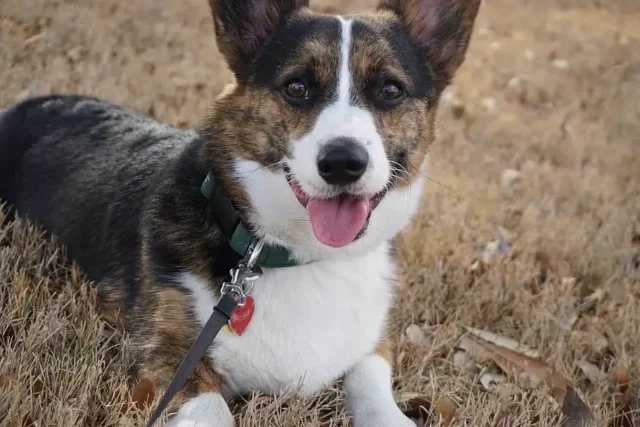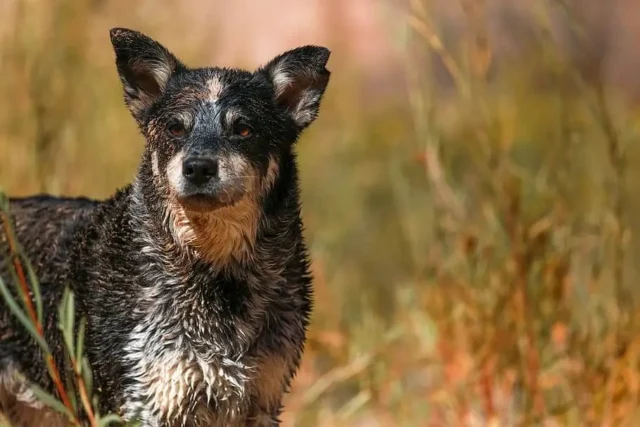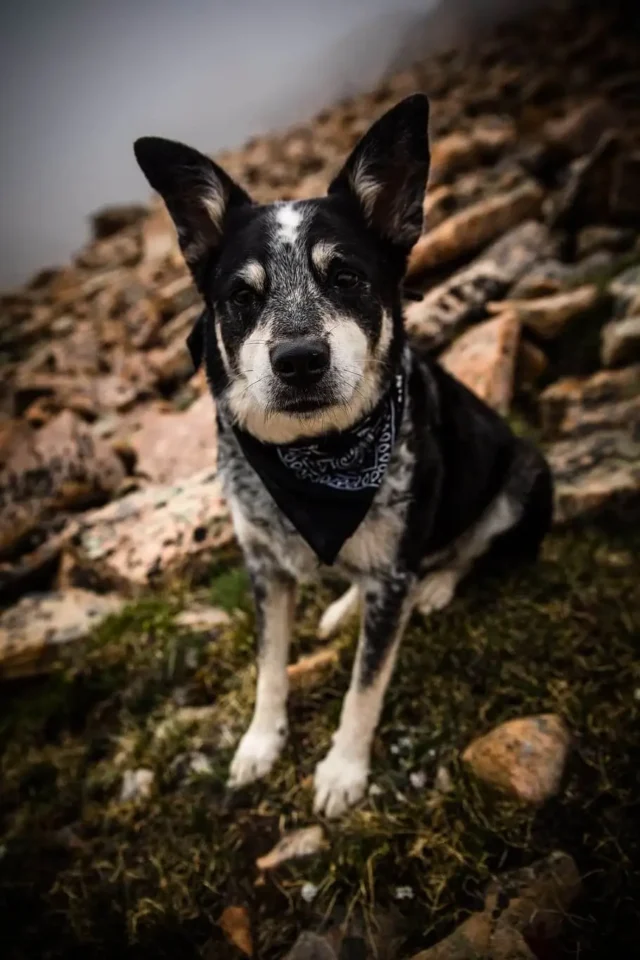The Blue Heeler corgi mix, a lovely hybrid of the Welsh Corgi and the Australian Cattle Dog, also known as the Blue Heeler, is a cute puppy that wins people over with its endearing look. These vivacious friends have tremendous energy, so they need lots of fun to keep them happy. Be ready for an energetic and lively addition to your family when you bring a Cowboy Corgi home.
Cowboy Corgis are incredibly clever and simple to teach despite their exuberant personality. They want affection from their loved ones and thrive on interpersonal contact. You may choose from a variety of colors and coat styles to get the ideal Blue Heeler Corgi Mix to realize your ideas. Find out if a Cowboy Corgi or a Blue Heeler Corgi hybrid is the right puppy for you.

Understanding the Blue Heeler Corgi Mix
The Cowboy Corgi is the result of crossbreeding a Blue Heeler and a Corgi. These mixes are known to be friendly, intense, outgoing, energetic, loyal, and intelligent. Their life expectancy typically ranges from 12 to 15 years, and they can weigh anywhere from 15 to 85 pounds. The expected height for a Blue Heeler Corgi Mix is between 15 to 17 inches at the shoulder.
It’s vital to remember that Blue Heeler Corgi Mix features and physical attributes might vary from puppy to puppy. Each hybrid dog has its own set of personality traits and physical qualities. Prior to adopting any hybrid dog, it’s important to take into account a number of variables. The particular personality and temperament of a hybrid dog, like a Corgi crossed with a Blue Heeler, are benefits, but there are also some drawbacks.
The possible health problems that Blue Heeler Corgi Mix pets might have are among the considerable difficulties that many owners of these dogs confront. The Corgi Blue Heeler Mix, like any other hybrid dog, may inherit specific genetic health issues from both of its parent breeds. It’s crucial to be informed that, in comparison to other dog breeds, this hybrid might be more prone to health problems.
Why Do People Give Warnings About Heelers?
Personality Traits of the Blue Heeler Corgi Mix
Corgi Heeler mixes are known for their high energy levels and outgoing personalities. They are typically friendly, affectionate, and loyal to their families, particularly their owners. These intelligent dogs thoroughly enjoy learning new things, making them highly trainable. However, their stubborn streak can present challenges for inexperienced dog owners during training sessions.
Due to their high prey drive and herding heritage, Corgi Heeler hybrids may engage in some natural behaviors like biting at heels or chasing after small animals. Early socialization and training are vital to manage and control these behaviors effectively. Providing them with ample physical and mental stimulation, such as daily walks, playtime, and training sessions, is crucial to prevent boredom and destructive behaviors.
Exercise and Living Conditions
With two parent breeds known for their active and performance-driven nature, your Blue Heeler Corgi pup will require multiple exercise opportunities each day. Since Blue Heelers make excellent jogging partners and the Corgi side of your dog shouldn’t restrict their legs too much, your mix will likely enjoy daily jogging or brisk walks around the neighborhood.
Being working breeds, these blended pups thrive when they have a “job” to do. While they excel in herding cattle on a farm, living in an urban setting requires creative ways to channel their energy. Participating in canine sports like agility can be a great outlet to positively utilize their energy and mental abilities.

Training Considerations
A Blue Heeler Corgi blend is eager to work and may exhibit an intense work ethic, particularly if they lean more toward their Australian Cattle Dog parent. Both breeds are intelligent and bred to work closely with humans. However, as herding or shepherd dogs, they also possess an independent streak, making their own decisions at times. Patience, perseverance, and consistent positive reinforcement are key when training a blue-heeler corgi mix. Meeting their exercise needs and rewarding good behavior will contribute to a calm and well-behaved companion at home.
Early socialization with other dogs is crucial to ensure your ACD Corgi blend remains calm and well-behaved around other family members, pets, and pups. If you bring your blend home as a puppy, it’s important to introduce them to cats early on and supervise their interactions until they mature. Keep in mind that their herding instincts may trigger a high prey drive, leading them to chase small animals, which can have unfortunate consequences.
Blue Heeler Corgi Mix Pros And Cons
| Pros | Cons |
|---|---|
| Energetic and playful | Requires regular exercise and mental stimulation |
| Intelligent and trainable | Can be stubborn at times during training |
| Loyal and affectionate | May exhibit herding instincts and nip at heels |
| Gets along well with children | Potential for separation anxiety if left alone for long periods |
| Good with proper socialization | Moderate to high shedding levels |
| Adapts well to apartment living | Possibility of inheriting health issues from parent breeds |
| Potential for forming strong bonds | Requires regular grooming to maintain coat health |
| Can participate in canine sports and activities | May have a tendency to bark and howl |
| Suitable for active individuals and families | Needs a dedicated owner who can provide attention and care |
| Unique and adorable appearance | May chase small animals due to prey drive |
Health Considerations
The Blue Heeler Corgi mix inherits its genes from two generally healthy parent breeds. However, there are a few genetic predispositions to consider. While the incidence of negative recessive traits is lower when blending breeds with different foundation stock, certain genetically linked disorders can occur in individuals from both parent breeds. It’s crucial to monitor your Blue Heeler Corgi blend’s growth rates and consult your vet if any gait abnormalities are observed. They may have an average incidence rate of elbow and hip dysplasia and could inherit a predisposition for progressive retinal atrophy (PRA).

Proper Nutrition
To ensure the health of your Blue Heeler Corgi blend, it’s important to feed them a high-quality dog food formula that meets the standards set by the Association of American Feed Control Officials (AAFCO). Choose a formula specifically designed for their life stage. During their first year, feed them for moderate growth to reduce the risk of dysplasia-related health issues. Follow the feeding guidelines provided on the food brand’s packaging and monitor their body condition to adjust their intake if necessary. A high-quality kibble that includes meat protein, fiber, healthy carbohydrates, omega-3 fatty acids, vitamins, and minerals will fulfill the nutritional needs of your energetic blend.
Grooming Needs
To efficiently remove dog hair from floors and upholstery, you may need a reliable vacuum cleaner for managing the thick coat of a blue heeler corgi mix. You should look for a lightweight vacuum that can handle various surfaces in your home or car. The Bissell Featherweight Cordless XRT, a convertible stick vacuum with specialized pet tools, is a suitable option. It can effectively tackle pet hair by converting it into a handheld vacuum with a crevice tool and upholstery brush. Although this lightweight vacuum efficiently manages hard surfaces and area rugs, keep in mind that it may not provide enough power for homes with wall-to-wall carpets. If you have a fully carpeted home, you should consider a more powerful option like the Bissell ICONPet Edge.

Breeders and Puppy Costs
Despite the fact that Blue Heeler and Corgi hybrids may not be the most common combination, they can naturally happen as both parent breeds are well-liked by equestrians. These mixes are not purebred and cannot be registered, but they may be available from homebred litters. The price of a Blue Heeler Corgi Mix puppy can range from $150 to $500, depending on the demand in your area.
Australian Cattle Dog (Blue Heeler) History
Originating in Australia, where they were developed primarily for herding cattle in the wide grasslands, the Blue Heeler, also known as the Australian Cattle Dog, is a breed that is still in use today. Cattlemen crossed the Smithfield Sheepdog, imported from England, with the native Dingoes of Australia to create a more robust breed capable of withstanding the challenging conditions of the Outback, including high temperatures and rough terrain. The breed was further refined by incorporating Dalmatians and Kelpies. It gained recognition from the American Kennel Club (AKC) in 1980.
The temperament of the Blue Heeler Corgi Mix
When considering a designer dog like the Blue Heeler Corgi mix, understanding their behavior, interaction with people and other pets, and overall personality is essential. This mix is a fun-loving, intelligent, and outgoing dog that exudes energy and enthusiasm. They are loyal and enjoy the company of their human family. Their high energy levels make them a perfect fit for families leading a healthy, active lifestyle.
It’s worth noting that the Blue Heeler Corgi mix may not be suitable for novice dog owners with limited experience in handling active dogs. Despite their energy, they can adapt well to apartment living due to their small to medium size. However, providing them with ample space for playtime and exercise is advisable.

Being descendants of herding and guarding dogs, Blue Heeler Corgi mixes may exhibit a tendency to howl and bark at strangers or in threatening situations. Early socialization plays a vital role in correcting these behaviors. Additionally, they can experience separation anxiety if left alone for extended periods. They thrive on companionship and attention, so they are best suited for individuals who can consistently devote time to them.
This loving and friendly dog gets along well with children, making them excellent playmates. Their small size reduces the risk of posing a threat to small kids and other pets in the household.
Blue Heeler Corgi Mix – At a Glance
| Weight: | 26 – 40 pounds |
| Height: | 13 – 20 inches |
| Lifespan: | 10 – 16 years |
| Coat Colors: | Black, white, blue, red, brown |
| Temperament: | Energetic, intelligent, worker, independent, active |
| Most Suitable For: | Active families, farmers, and homesteaders are not suitable for the elderly or apartment dwellers. |

Conclusion
In conclusion, the blue heeler corgi mix, a crossbreed between the Welsh Corgi and the Australian Cattle Dog (Blue Heeler), is a lively and energetic companion. With their playful nature, intelligence, and loyalty, they make wonderful pets for individuals or families who can provide them with the exercise, training, and socialization they require. While they may have some challenges, such as their herding instincts and potential health issues, the joys and benefits of having a blue heeler corgi mix as a loving and devoted member of the family outweigh the drawbacks. If you’re ready for an active and affectionate addition to your household, the blue heeler corgi mix might be the perfect choice for you.
Essential Products to Keep Your Blue Heeler corgi mix Happy and Healthy
FAQs
Q1: Do Cowboy Corgis require a lot of exercise?
Yes, Cowboy Corgis are an energetic mix and require regular exercise to keep them happy and healthy. To address their fitness demands, daily walks, playing, and interesting activities are required.
Q2: Are Cowboy Corgis easy to train?
Absolutely, Cowboy Corgis are smart and often simple to teach. They pick things up fast and are eager to please. They may be obstinate though, so constant and persistent teaching techniques are necessary.
Q3: Do Cowboy Corgis get along with other pets?
Cowboy Corgis can get along well with other pets if properly socialized from a young age. Early introductions and positive experiences with other animals can help them develop good relationships.
Q4: Do Cowboy Corgis shed a lot?
Yes, Cowboy Corgis have a moderate to high shedding level. They have a double coat that requires regular brushing to manage shedding. They shed more heavily during seasonal transitions.
Q5: Are Cowboy Corgis suitable for apartment living?
While Cowboy Corgis can adapt to apartment living, they have high energy levels and need ample exercise and mental stimulation. Access to outdoor spaces and regular exercise routines are important to keep them happy in an apartment setting.
Q6: Do Cowboy Corgis have any health issues?
Like any mixed breed, Cowboy Corgis can inherit health issues from their parent breeds. Common concerns include hip and elbow dysplasia, progressive retinal atrophy (PRA), and potential weight gain. Regular vet check-ups and a healthy lifestyle can help mitigate these risks.
Q7: How big do Cowboy Corgis get?
Cowboy Corgis can vary in size depending on the genetics inherited from their parent breeds. On average, they are medium-sized dogs, ranging from 15 to 17 inches in height at the shoulder.
Read also
- Tough Dog Toys: Durable Toys for Your Pup | Buy Today
- Find the Best Dog Food for Your German Shepherd
- Discover Why Dogs Chew on Their Paws: Common Causes and Effective Solutions
- Lion Dog Breed: A Perfect Blend of Beauty and Grace
- Dog Muzzle for Barking: Control Excessive Noise with Effective Muzzles
- Find Your Perfect Match: Discovering the Ideal Target Dog Breed
- Super Chewer Dog Toys: The Ultimate Guide for Aggressive Chewers
- Discover the Benefits of High Protein Dog Food for Optimal Canine Health
- Best Dog Food for Older Dogs: Nourishing Your Senior Canine Companion
- Unlock Duck Hunting Secrets: Most Effective Dog Breeds
- Discover the Majestic Big White Dog Breed: A Guide to These Magnificent Canines
- World of Blue Dog Breeds – Unveiling Their Unique Charisma
- Nutritional Yeast for Dogs: A Comprehensive Guide
- Dog Hiking Gear: Essential Products for Your Canine Companion
- Best Dog Food for Pitbull Puppies: A Guide to Nourishing Your Furry Friend
- Best Dog Food for Labrador Retrievers: Providing Optimal Nutrition
- Unleash the Best Dog Food for Chihuahuas | A Guide for Optimal Nutrition
- Hunting Dog First Aid Kit: Essential Supplies for Your Canine Companion
- Top 10 Best Dog Raincoats | Keep Your Furry Friend Dry in Style
- Avoid Common Mistakes in Puppy Crate Training!




